The seven-member Korean boy band BTS have emerged as a sociocultural juggernaut, leaping over borders and captivating millions of fans around the world. Their influence is enormous, making them a global phenomenon comparable to The Beatles craze of the 1960s. Where did it all start?
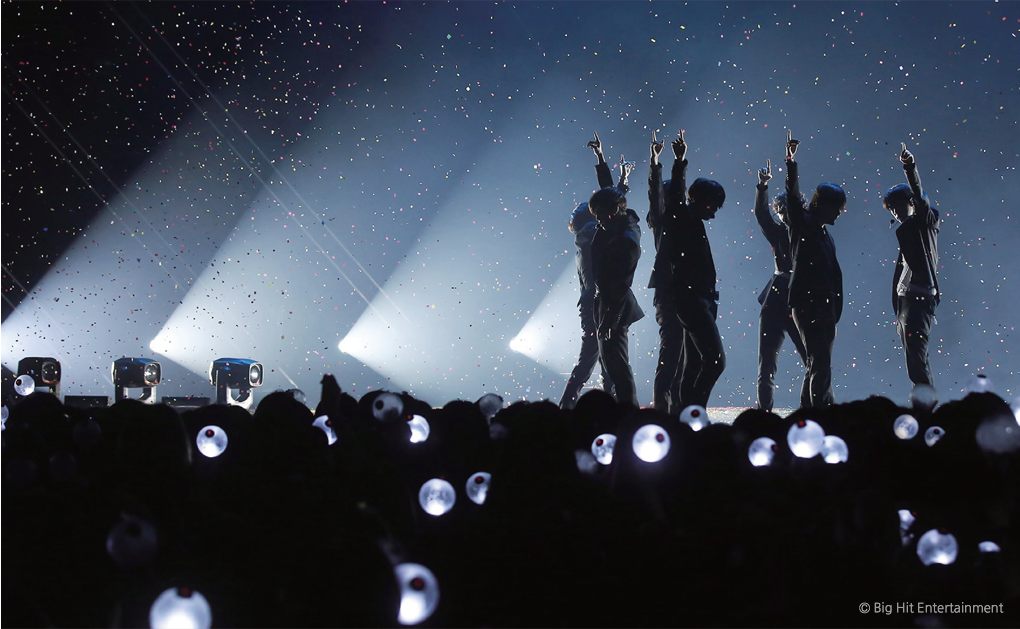
The 2019 BTS world tour “Love Yourself: Speak Yourself” kicked off on May 4 at the Rose Bowl in Pasadena, California, and ended triumphantly on July 14 at the Ecopa Stadium in Shizuoka, Japan. The sellout tour covered eight cities and drew 860,000 fans. This photo was posted on BTS’s Facebook page for the “2019 BTS FESTA,” held in early June to mark the sixth anniversary of the band’s debut.
Every young generation finds its coming-of-age voice through a particular singer or group. The artists best suited for a worldwide following presumably are “mainstream,” linked to major music producers and performing in English, the universal lingua franca. BTS have upended that assumption: they come from a modest entertainment company, sing in a language that less than one percent of the world population understands, and do not even conform to their genre, K-pop.
Although BTS songs are based on the trials and tribulations of growing up in Korea, their essence strikes emotional chords regardless of nationality or culture. That is the high octane of the seven “boys” with the stage names RM, Suga, Jin, J-Hope, V, Jimin and Jungkook. Drawing on their own experiences, they comment on self-doubt, parental pressure, frustrated dreams and institutional failures. Their thoughts and emotions assure fans that they are not alone. Fittingly, the name BTS is derived from Bangtan Sonyeondan (Bulletproof Boy Scouts), denoting “resilience and protection.”
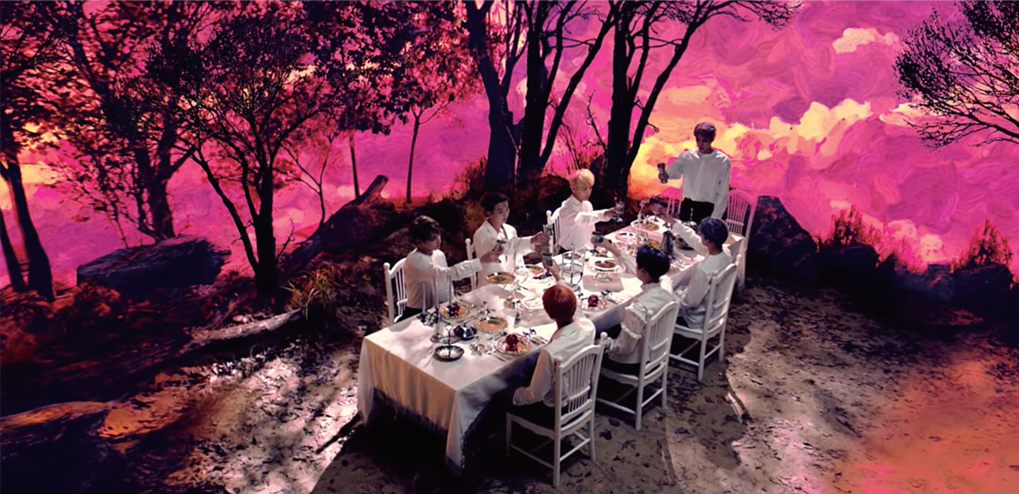
Scenes from the music video for “Blood Sweat & Tears,” the title song of the second BTS album “WINGS,” released in 2016. The song’s motif comes from Hermann Hesse’s novel “Demian: The Story of Emil Sinclair’s Youth.”
Emotional Chords beyond Borders
In this era of social media, BTS’s musings are amplified thousands of times over. The group’s well-organized global fan base, called ARMY (Adorable Representative M.C. for Youth), immediately translates, dissects and shares new BTS songs and videos in many languages, rendering linguistic and physical barriers non-existent. Korean and English words also are mixed for a “K-pop vocabulary,” which includes s such as baepsae (parrotbill or crow tit, a small bird indicating something weak or insignificant) and heuksujeo (dirt spoon), that are used to describe impoverished origins K-pop, of course, has had many popular groups since its birth in the early 1990s. But the recognition of BTS is unprecedented. The group has won Top Social Artist three consecutive years at the Billboard Music Awards. They are the first group since The Beatles to have three No. 1 albums in the Billboard 200 chart within a year. Time magazine has included the septet on its global lists of next-generation leaders and the most influential people on the internet.
“The success of Drake, BTS and Ariana Grande has helped the music industry earn its biggest revenues in a decade. The music market is now worth US$19 billion, close to the level of 2006,” says the International Federation of the Phonographic Industry, which represents the global music industry. “An explosion in streaming subscriptions has essentially saved the industry, which was in freefall for a decade.”
At home, BTS members are the youngest recipients of the Order of Cultural Merit, a presidential award to honor their contributions in spreading Korean culture and language. The group generates US$3.6 billion for the Korean economy annually, according to the Hyundai Research Institute. They hold the record for best-selling album (“Map of the Soul: Persona) and are the best-selling artists in history.
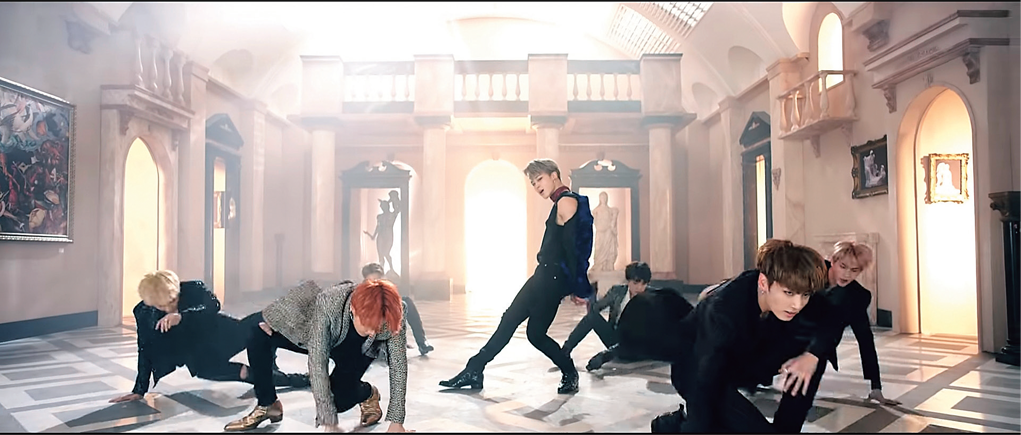
Scenes from the music video for “Blood Sweat & Tears,” the title song of the second BTS album “WINGS,” released in 2016. The song’s motif comes from Hermann Hesse’s novel “Demian: The Story of Emil Sinclair’s Youth.”
Breaking the Mold
The genesis of BTS stemmed from failure. In 2012, Bang Si-hyuk, CEO of Big Hit Entertainment, misfired with a new female group called GLAM. Searching for a way to rebound, he decided to depart from the traditional approach of training and managing “idols,” or mainstream K-pop acts.
Before BTS, popular Korean idol groups were often criticized as “factory products” of intensive competition and training that lasted years before they debuted. It was a constant viewpoint of foreign media reports. When Jonghyun, the main vocalist for the boy band Shinee, committed suicide in December 2017, Variety wrote, “The Korean entertainment industry fosters a ‘Hunger Games’-like work environment.”
Referencing the success of two groups from much bigger entertainment companies — Big Bang managed by YG Entertainment and EXO under SM Entertainment — Bang dissected the music market and concluded that artists, not mere idols, were the answer.
Instead of simply training individuals and groups in hopes of a few hit songs in a typically brief career, Bang and Big Hit Entertainment would seek ways to give its wannabes a long-term presence. To that end, Bang believed it was much more important to help his entertainers develop the ability totheir own songs. The business model reincarnation from idol to artist along with a focus on the global stage re-energized K-pop.
Known as “Hitman” for his knack of composing top songs, Bang’s role has not gone unnoticed. In 2017, he received the Presidential Commendation at the Korea Content Awards, and in 2018, Variety named Bang an International Music Leader. Moreover, recognizing BTS’s status, the U.S. Recording Academy invited Bang and BTS to the select group of music industry members to vote in the 2020 Grammy Awards.
During their trainee days, Bang would ask the BTS members, “What are you thinking these days?” “Don’t you have anything you want to say?” In this way he encouraged them to delve into themselves and find their own stories.
Traditionally, K-pop fans favored idols who shone as singers and dancers. While song and dance skills gained through long years of hard training were still required to hone BTS’s stage presence, the boys were encouraged to express their personal opinions and their thoughts and interpretations of issues. Otherwise, they could not be protagonists of their music.
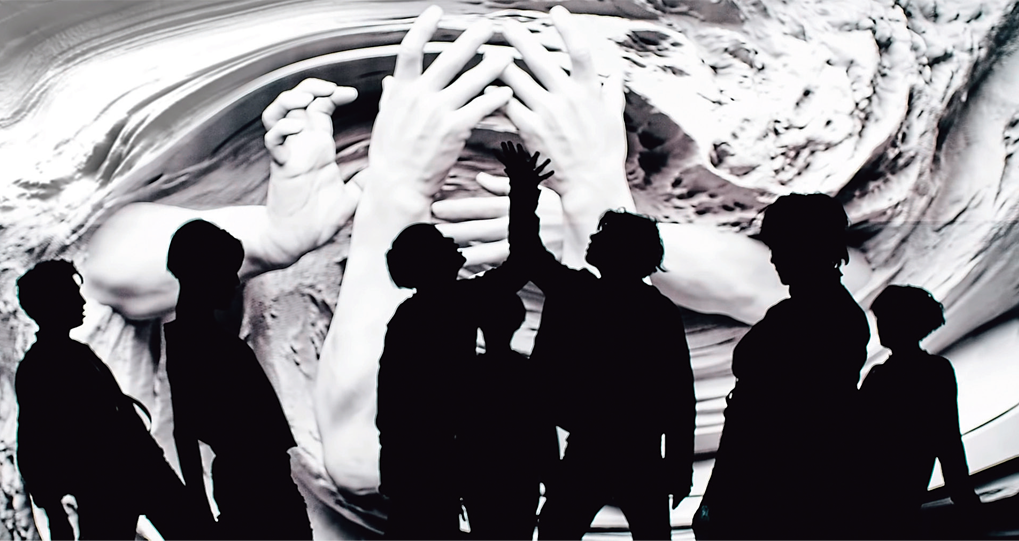
A scene from the music video for “Fake Love,” the title song of the third BTS album “Love Yourself: Tear.” This song has been described as “emotional hip hop” for being atypically melancholic and uneasy for the genre.
Mind and Soul
Big Hit Entertainment’s operational model for BTS naturally demands a kind of creativity alien to typical Korean boy bands. The BTS crew must be able to interpret in their own way not only the music but everything surrounding them, understanding the interrelationships and contexts of their environment. All members, starting with RM and Suga, are equipped with this ability.
BTS began learning to take charge even before their 2013 debut. Media interviews became opportunities for articulate explanations of their thoughts on music, the result of endless discussions among themselves, reading books and self-reflections.
Recurring themes of BTS have included the growing pains of youths, mental health, shortcomings of institutions and young adults losing hope. In short, BTS songs ring with a social consciousness that has managed to leap across borders to connect in different cultures. Fans everywhere say the songs give them solace and motivation.
“I think audiences today are smart and sophisticated. They can tell right away what is genuine and what is not,” said RM (Rap Monster), the group’s first member and leader. “While being faithful to our main job, we make an effort to convey our true feelings and thoughts a little bit better through social media.”
To deliver their stories, hip hop was considered the best vehicle because it asks singers to write songs about their own experiences andstrong stage personalities with their own messages. RM and Suga had already paid their dues in the underground hip hop scene before becoming part of BTS. The timing was opportune. The year 2013, when BTS debuted, was a watershed year for hip hop. Rappers such as Kanye West and Kendrick Lamar were at the height of their popularity. Hence, the strong hip hop tendencies in BTS songs are not only a result of the members’ personal preferences but also of the marketing strategy adopted to find a breakthrough.
Success did not come overnight. Not being exactly an idol group or a rap group, BTS did not quickly win over fans of either genre. Coming from a small entertainment agency instead of the behemoths SM, YG and JYP also ensured an under-the-radar debut. Overseas, BTS faced the same stereotyping that all Korean boy bands faced. That is, they lacked depth, had no message and could not possibly be a mainstream pop act because they cannot sing in English. Also, idols were not supposed to discuss social and political issues or be candid about their emotions and life experiences.
Even now, with BTS unparalleled as the top boy band in the world, negativity has not receded completely. Critics dismiss BTS’s music and say the group is mainly the product of a huge global fan base that coordinates through social media. Twitter says the BTS account has 21.5 million followers.
“We have talked about the things that we know best. In our teens it was school, in our twenties it was youth. Those stories have been built up, producing ‘Love Yourself” and ‘Persona’ in the process.”
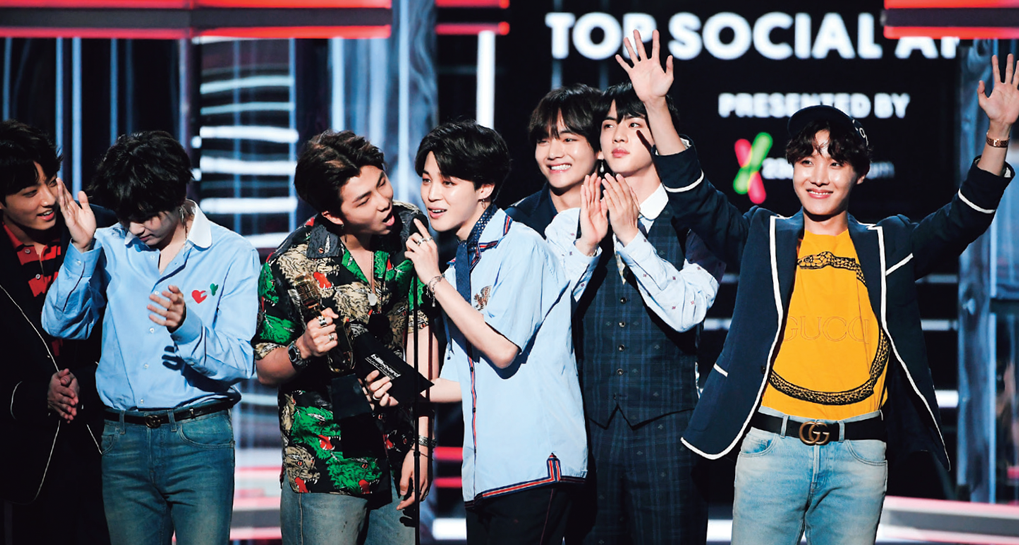
BTS deliver their acceptance speech for the Top Social Artist Award at the 2018 Billboard Music Awards, held May 20, 2018, at the MGM Grand Garden Arena in Las Vegas. The band has won this award three years in a row since 2017.In 2019, they also won Billboard’s Top Duo/Group Award.
Generation Z
“Netizens instinctively reject contents that smell of publicity. So, contents have to be fun. You’re making a show. There’s no need to get all serious. You suggest, ‘What about this?’ That’s enough. If this were literature, a novel by Haruki Murakami would do. It’s important to make people feel before perception gets in the way,” Bang Si-hyuk said years ago.
He described the production of contents as “pleasantly deceiving the audience.” Like putting together the pieces of a puzzle or finding hidden pictures, the legions of BTS fans interpret the meaning of their songs, find the hidden symbols and metaphors in their music videos, and compare answers and observations with each other. In itself, this is a form of digital game that they voluntarily engage in.
It must also be noted that the members of BTS have the attributes of Generation Z. Born between 1995 and 2005, they grew up with consumer electronics. A generation dreaming of being creators, professional gamers, computer programmers or startup founders, they live life in their own way, not the way their parents want. They are quick to pursue their interests and express their opinions and convictions, rather than sit on the sidelines. In addition, rather than just watching things d by others, theytheir own. In short, they represent a carpe diem (seize the day) generation who takes action.
These defining traits of Generation Z overlap with BTS in many respects. The BTS members put their own experiences and thoughts into their songs and share them on social media, which is fitting for these representatives of Generation Z, who forge their own lives.
The members of BTS are now in their early to mid-20s. Naturally, one wonders what they will present in the coming years. RM once said, “We have talked about the things that we know best. In our teens it was school, in our twenties it was youth. Those stories have been built up, producing “Love Yourself” and ‘Persona’ in the process.” Already, they have transitioned from hip hop to other genres. In 2017, BTS announced their name would also mean “Beyond the Scene,” suggesting they were looking forward to surpass the next hurdles.
After conquering the world stage, the next frontier is out of this world — literally. The U.S. National Aeronautics and Space Administration’s playlist for its trip to the moon in 2024 includes three BTS songs: “Moonchild,” “Mikrokosmos” and “134340.”
‘Little Father’ to the Boys

Pdogg Chief Producer
To BTS, Pdogg (Kang Hyo-won) is jageun abeoji, literally “little father.” It is the salutation for an uncle, specifically the younger brother of one’s father, which indicates Pdogg’s influence on the group. All of BTS’s music, from the debut single “2 Kool 4 Skool” to the latest album “Map of the Soul: Persona,” has passed through his hands as chief producer of Big Hit Entertainment.
Pdogg met Big Hit’s CEO Bang Si-hyuk in 2007, soon after Bang founded the company. He brought his deep knowledge of Western hip hop and other genres. He has guided BTS’s stage presence and helped develop the members’ composing to narrate their personal experiences. He once said the preparatory phase to ready the group was so difficult that he thought he would die: “I climbed this mountain, that mountain, all of them.”
In 2018, he became the Korean producer with the highest earnings in copyright revenue, and earlier this year, at the 56th General Assembly of the Korean Music Copyright Association (KOMCA), he received two KOMCA Music Awards for the highest earnings in royalties for composition and lyrics.
From Dance Routines to Facial s
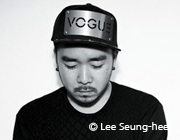
Son Sung-deuk Performance Director
BTS’s choreography is extremely ambitious and difficult. Son Sung-deuk s the dance routines as well as virtually every other movement on stage, including gestures and s. His influence is immense as the dances he choreographs are followed by BTS fans all over the world.
In the early years of BTS, each member had a fairly clear-cut role, so the choreography revolved around J-Hope and Jimin.
But as their cohorts’ dancing made huge strides, the choreography spotlight shone on the entire group. “At first it was a bit awkward adding performance elements to hip hop, and the hardest thing was making it look natural,” Son said in a past interview.
Son began to take dance seriously when he was in his mid-teens and now has more than 20 years’ experience. In his freelancing days, he directed the choreography for some of Korea’s most famous idol groups of the late 1990s to the early 2000s, including Sechs Kies, Fin.K.L and Shinhwa. When Big Hit was launched, he began working on the performances of 2AM (in cooperation with JYP), GLAM and BTS.
Creator of Seven Fashion Icons

Kim Sung-hyunVisual Creative Director
Like other Big Hit executives, Kim Sung-hyun’s title belies his total contribution to BTS’s success. He is the fashion designer, so he naturally has tried countless outfits on the group members since their trainee days, eventually turning them into fashion icons.
Clothing and accessories are just one part of Kim’s control over every visual component that BTS audiences and fans see.
That includes album covers, video scenery and stage backdrops. He oversees two teams of fashion stylists, visual designers, video art specialists and editorial designers. Their work is inevitably linked to the concepts and messages that BTS convey and ends up having a huge impact.
Recalling the mini albums “The Most Beautiful Moment in Life,” Kim said he watched numerous movies to explore the concept. His viewing included “The Dreamers,” “Basketball Diaries,”
“Trainspotting,” “Dead Poets Society” and “Flipped” as well as the works of American director Larry Clark, which mostly deal with teenage delinquency. Kim loves rock music almost as much as hip hop and says he often looks to other music genres for inspiration.
Music Videos Replete with Surreal Aesthetics

LumpensVideo/Art Director
BTS’s highly popular music videos, including “Blood Sweat & Tears,” “Fire,” “Spring Day,” “DNA,” “Fake Love” and “IDOL,” have been the work of Lumpens (Choi Yong-seok). Many of the group’s music videos, deftly crafed non-stop feasts for the eyes, have garnered hundreds of millions of views on social media.
As a visual artist, Lumpens is being touted as the second Nam June Paik, the father of video art. Although he is a freelancer, not a full-time Big Hit employee, he has been actively involved with BTS since the group’s debut in 2013.
Aesthetic devices are multied throughout BTS music videos. They may contain enigmatic symbols and metaphors of surrealist ambience or simple find-the-hidden-picture elements. The myriad signs and schemesample room for fans throughout the world to interpret and discuss, interacting briskly.
Lumpens draws his ideas from movies and novels. In the trailer for “Map of the Soul: Persona,” he added a sci-fi element by employing the latest technologies toa giant digital humanoid persona of BTS leader RM.